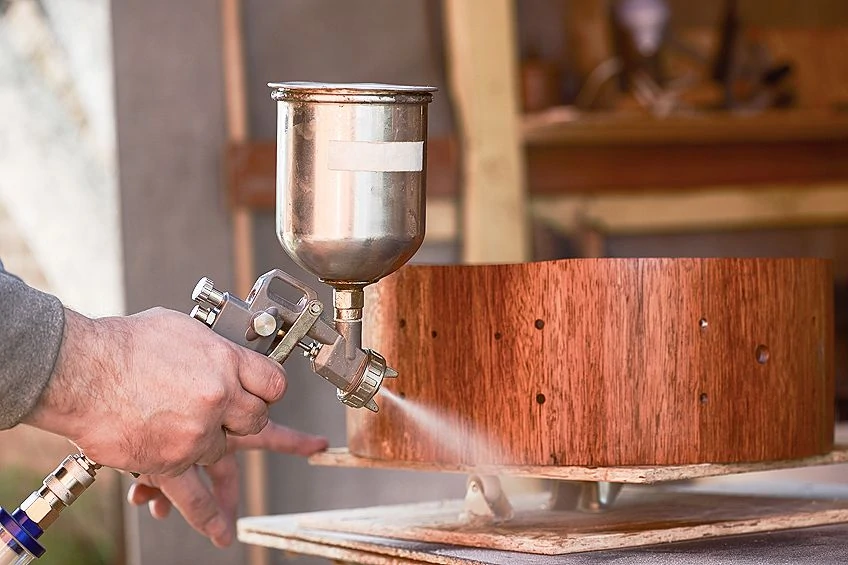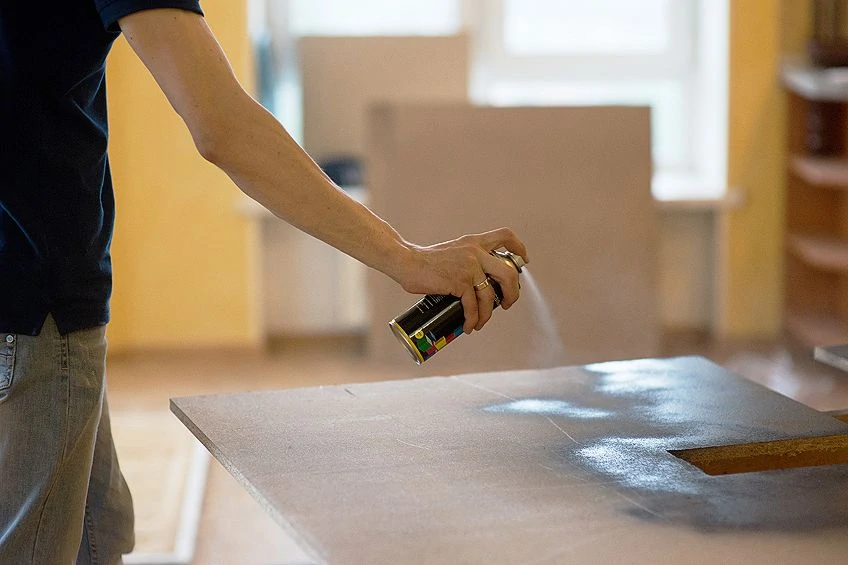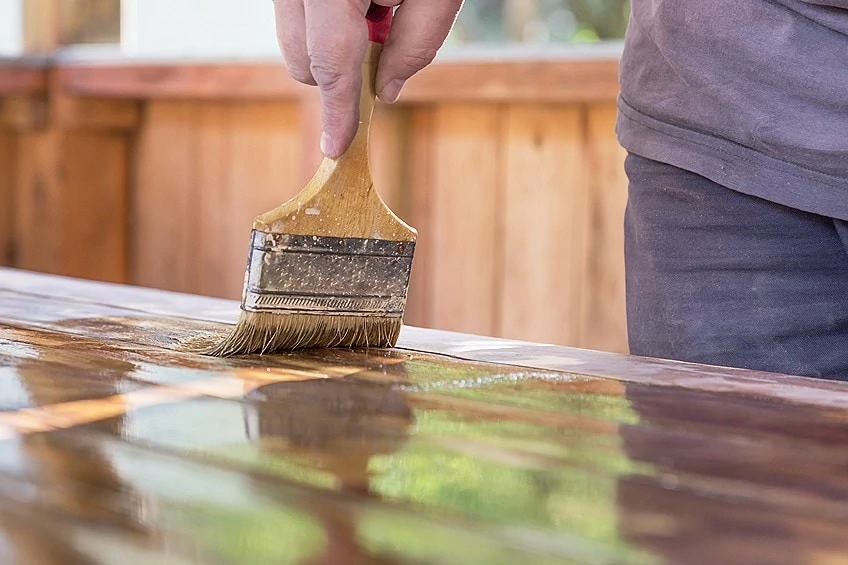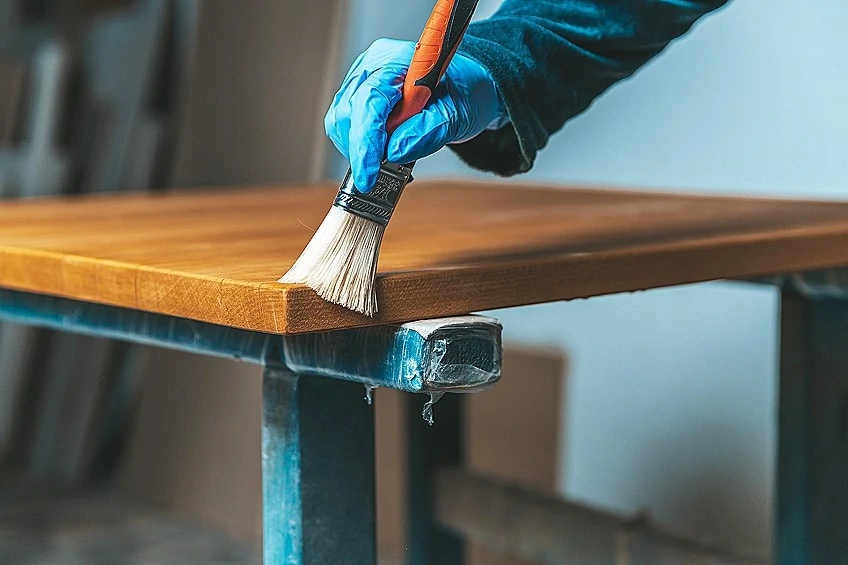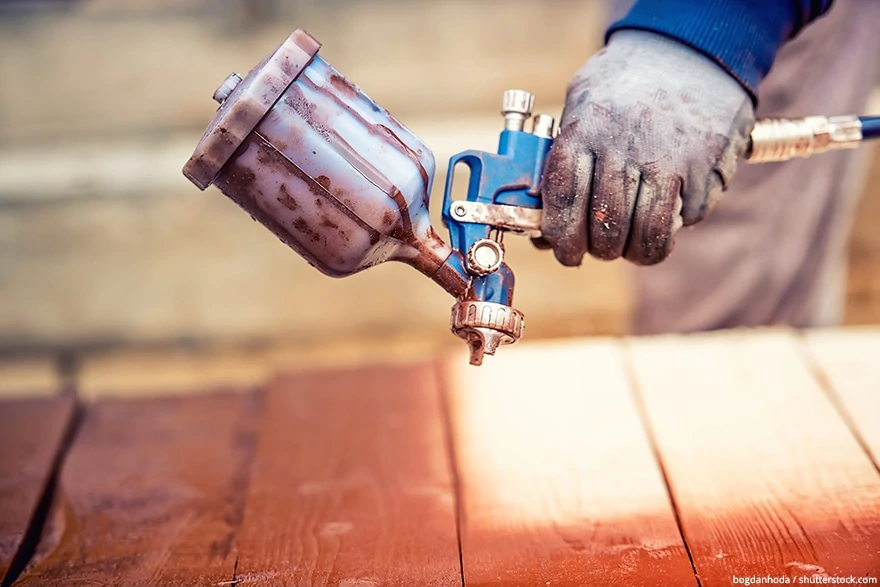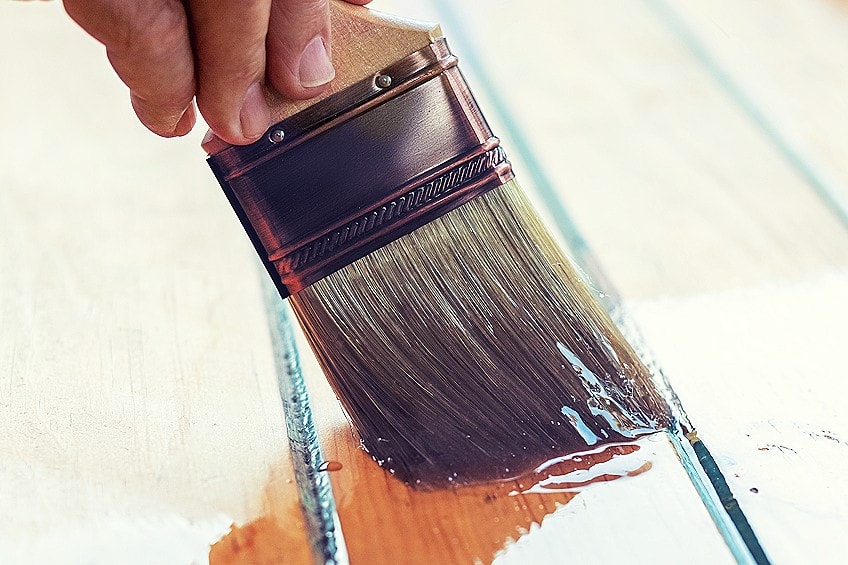Lacquer vs Polyurethane – The Differences of Poly Over Lacquer
This post may contain affiliate links. We may earn a small commission from purchases made through them, at no additional cost to you. You help to support resin-expert.com
Painting and refurbishing wood can be hard work, so you want to make sure that the products chosen bring out the best in your wood piece. There are many products available to do this, so it can be a little bit of a challenge to choose the products that offer the best results for your project. This is also true when deciding on lacquer vs polyurethane, as both provide certain benefits, and also come with some disadvantages. Sometimes, these types of finishes are not needed, and a good coat of quality furniture oil will do the trick. But for now, let us take a closer look at polyurethane vs lacquer for the best durable topcoat.
Table of Contents
What Is Lacquer?
Lacquer is a favorite durable finish preferred by many, and is not the same as varnish. There are many differences, the main ones being their consistency and ingredients. Lacquer for one is a lot thinner than varnish and provides a more durable, clear finish. Some also confuse lacquer with shellac, which is made out of the shellac from the lac beetle. This is dissolved in alcohol that then gives you a durable and high-gloss finish. Shellac, however, is placed in its own category.
The traditional form of lacquer comes from the lacquer tree itself, which is native to China. The tree sap is collected and the resin harvested. The resin goes through a refining process which is then added to a lacquer thinner.
Then there are the more modern synthetic lacquers, which come in different forms. These consist of synthetic polymers dissolved in a lacquer thinner and provide a more durable finish as well as other benefits, especially when compared to a finish like shellac. We will be dealing mainly with nitrocellulose lacquer when referring to what is lacquer. Other types of lacquer include:
- Acrylic Lacquer
- Nitrocellulose Lacquer
- Water-Based Lacquer
- Catalyzed Lacquers
Acrylic Lacquer
This type of lacquer was mainly designed to prevent yellowing, especially over lighter-colored woods. This lacquer contains acrylic resins that are ‘water white’ and provides a clear finish that remains that way, unlike nitrocellulose lacquer, which yellows over time. The most common form of this type of lacquer is known as CAB-acrylic lacquer.
Another benefit of this type of lacquer is that it is more flexible and less brittle than the nitrocellulose variety. However, you will be paying more for these benefits. Acrylic lacquer is best sprayed on and can be diluted with lacquer thinner to reach the desired consistency. Like all lacquers, it is quick-drying and can be used on furniture, kitchen cabinets, and other interior wood surfaces.
Nitrocellulose Lacquer
Nitrocellulose lacquer has been around for a long time and is the most common lacquer used. Although, with so many developments and alternatives, it is being pushed further and further down the list. This lacquer consists out of a fast-drying solvent that contains a plant-based substance such as cotton, along with sulfuric and nitric acids. The nitrocellulose, which has been broken down by the acids from the cottonm, is the binding agent in the solvent. It has been used in the automotive industry and has since become popular in the furniture industry.
Nitrocellulose lacquer is affordable and dries quickly into a protective single coat. However, the coat will yellow over time and may even shrink and cause cracks. The final coat is also heat sensitive and prone to scratches. When spraying the lacquer, you must wear a respirator mask, gloves, and protective eyewear, and be aware that the product is flammable. It also has various application issues that could cause things like blushing, which makes the coat appear milky when moisture is trapped. This can, however, be remedied by adding in a thinner that dries more slowly.
Water-Based Lacquer
We all know that solvent-based lacquers are toxic and are not eco-friendly, which is why the water-based lacquers were developed. They are a lot less toxic, are more eco-friendly, do not pose a fire hazard, dry quickly, and provide adequate results. Even though the water-based lacquers are less toxic, you should still consider all the usual safety precautions when using them. These are becoming more popular for use on furniture and in other industries, and come in clear or colored lacquer varieties.
Catalyzed Lacquers
These were developed to offer even better resistance to water, chemicals, and abrasions. This type of lacquer cures through evaporation as well as chemically. The lacquer consists of nitrocellulose resins but also has urea resins added, making the product super durable. To initiate the chemical cure, an acid catalyst has to be added. This can be added either at the store, so you buy it pre-catalyzed, or you can purchase the catalyst yourself and add it in, which is known as post-catalyzed lacquer.
This might be a more challenging choice, however, as you need to be accurate when mixing, but it still has the same ease of application as the other lacquers.
Pros and Cons of Lacquer
What is lacquer? There does not seem to be a simple answer, as you can see from all the options available. The common thread that links all of these options is in their performance and function, where some offer enhanced properties to improve the finish concerning durability and resistance capabilities. Most lacquers have similar pros and cons, but below, we are mostly referring to the nitrocellulose variety.
PROS
- Lacquer is easy to apply using a paint can or paint sprayer, as it is thinner than other types of finishes. This means no brushstrokes and a more even application.
- It dries quickly in five to ten minutes.
- It is easier to repair, as the lacquer is absorbed by the wood and offers a long-lasting finish. Nitrocellulose “burns in” and will re-activate previous layers, which will reform a better single coat. This makes it easier to repair if needed.
- Lacquer dries clear and is a great option for a durable interior finish.
- Nitrocellulose lacquer is affordable and widely available.
- It is available in a variety of sheens.
- Lacquer is water-resistant.
CONS
- Nitrocellulose lacquer may yellow over time.
- Blushing may be a problem in high humidity.
- Lacquer is flammable.
- It poses a health risk if not used properly with safety precautions.
- Lacquer has no resistance to heat and chemicals, and nitrocellulose lacquer in particular is susceptible to scratches.
- Most have high volatile organic compound (VOC) levels.
- Most are not environmentally friendly.
- You may need to apply three to several coats.
- Lacquer is not ideal for outdoor surfaces.
- It collects dust easily, so the surface needs to be wiped off regularly.
Best Lacquer: RUST-OLEUM Specialty Lacquer Spray
The Rust-Oleum lacquer spray can be used on surfaces inside as well as outdoors. This lacquer can be used not only on wood but also on metal, unglazed masonry, and plaster. Once applied, it provides a coat that is hard and has a beautiful shine to it. The lacquer will dry to the touch quickly, in about 20 minutes, and a single spray can will cover an area of around seven square feet. To achieve an even better gloss finish, sand down the surface and then add a second coat.
- Ideal for use on interior/exterior surfaces for a smooth, ultra-gloss finish
- Acrylic formula offers an ultra-hard, lustrous finish with fast curing time
- Durable coating can sanded and recoated for a higher gloss finish
PROS
- Easy-to-use spray can
- Provides a high-gloss finish
- Dries quickly
- Offers a durable coat
- Can be used on surfaces outdoors and indoors
CONS
- Overspray might occur
- You will need to wear gloves, a mask, and protective eye-wear
- Not to be used on larger surfaces
What Is Polyurethane?
Polyurethane is another popular wood finish, preferred by many professionals who constantly work with wood. This product is essentially a plastic that is in a liquid state – that is, until it dries. Polyurethane comes in a variety of sheens from satin to a gloss finish. You also have two main varieties, including oil-based polyurethane and a water-based option.
Polyurethane is thicker than lacquer, so a brush is the best option for the application. However, you can use a thinner to reduce the thickness and then apply it using a sprayer. Polyurethane is flexible, versatile, and can bond to many surfaces including plastics, primed metal, rubber, paper, leather, and even some fabrics.
Oil-Based Polyurethane
An oil-based polyurethane dries slowly and gives an extremely durable finish, more than that of the water-based option. For your health, you must work in a well-ventilated area. Also, wearing protective gear is essential, as it is toxic and does have an odor. While lacquer is absorbed by the wood, polyurethane forms a durable top layer.
One disadvantage of using oil-based polyurethane is that it can yellow when applied over lighter colors. Mineral spirits are also required for cleaning. The product is great to use on wooden floors and tables and handles heat well. Oil-based polyurethane also handles moisture well, so it can be applied to outdoor wooden surfaces. Another advantage is that oil-based polyurethane is cheaper when compared to the water-based variety.
Water-Based Polyurethane
Water-based polyurethane is a preferred alternative for many, as it has no odor and is considerably less toxic. It does dry faster than the oil-based variety but is still slower than lacquer. You will also not get any yellowing over lighter colors. The water-based polyurethane is not resistant to heat, so it would not be a good idea for a kitchen tabletop. Cleaning up is also easier, as you only need some soap and water.
Polycrylic
This is a combination polyurethane option, which carries similar properties to both oil-based and water-based polyurethane. This water-based option has less odor and is less toxic than both oil-based and water-based polyurethane. It dries quickly, in about two hours, and needs at least 24 hours until it fully cures. Polycrylic is easy to clean up with some soap and water and will not yellow.
Pros and Cons of Polyurethane
In many cases, applying a protective coat onto wood is an important step and offers many benefits. There are many popular product choices available, each with different levels of durability and other advantages. Polyurethane, in all its forms, also offers many advantages and a few disadvantages that should be considered before going ahead with any project. Whenever in doubt, always read the product manufacturer’s instructions before purchase.
PROS
- Oil-based polyurethane is extremely durable and heat-resistant
- Water-based polyurethane and polycrylic are less toxic with a low odor
- Water-based polyurethane and polycrylic dry fast
CONS
- Oil-based polyurethane is toxic and requires careful handling
- Oil-based polyurethanes take longer to dry as well as fully cure
- Oil-based polyurethane may yellow over lighter colors
- Water-based polyurethane is less durable and not heat-resistant
- All polyurethane coats are difficult to repair
Best Polyurethane: MINWAX Fast Drying Polyurethane Clear Finish
The Minwax polyurethane is an oil-based clear finish that offers excellent protection to indoor wood surfaces. This product can be used on wood furniture, cabinets, doors, and floors. You can also apply the product to both unfinished and finished wood surfaces.
- Provides lasting beauty and protection to any interior wood surface
- Ideal for woodworking, furniture, doors, cabinets and floors
- Can be used on both finished and unfinished wood
PROS
- Dries faster than other oil-based options
- Can be sprayed on or brushed on
- Offers a durable, high-gloss, clear finish
CONS
- Can dry and harden in the nozzle if spraying
- Strong odor
Polyurethane vs Lacquer
Below, we have a table that briefly shows results for lacquer vs polyurethane. Even though both options form a hard sealant coat, they do have some differences, especially when it comes to consistency and drying times. There are also a few differences and similarities when it comes to brushing lacquer vs polyurethane. The application will depend on the product you buy, so remember to read the label before purchasing.
| Lacquer | Polyurethane | |
| Consistency | Thin | Thick |
| Cost | Costs less than polyurethane | More expensive than lacquer |
| Application | Using a paint sprayer is the best option, but you can also brush it on. Penetrates the wood and is applied in thin coats | You can brush it on, wipe it on, and use a sprayer. It will need thinning for the sprayer (foam brush and roller not recommended). Applied in thick coats that sit over the surface |
| Durability | Durable but susceptible to scratches, heat, and chemicals. Other varieties may offer more durability | Extremely durable. Oil-based polyurethane offers the highest durability |
| Dry Times | 5 to 10 minutes | Oil-based: 24 to 48 hours to dry, and completely cures in a month.
Water-based: 4 to 8 hours to dry, and fully cures in 30 days Polycrylic: dries in about two hours, and fully cures in 24 hours |
| Finish | Ultra-matte to a high gloss | Matte, satin, semi-gloss, and gloss |
| Toxicity | Toxic. Contains VOCs. Water-based is less toxic | Oil-based: Toxic
Water-based: Less toxic Polycrylic: Less toxic than water-based polyurethane |
| Uses | Can be used on wood, metal,and plastic. Best for indoor wood surfaces, but there are indoor/outdoor products available | Oil-based: Indoor and outdoor
Water-based: Indoor projects unless otherwise stated Polycrylic: Indoor projects |
Applying Lacquer
Since lacquer is a thin substance, you can apply it using either a brush or a sprayer. In fact, many lacquer products come in a spray can option. The brush-on lacquer does dry quite quickly, but you should have enough time to apply an even coat. You do not want any bristles getting into your coat, so it is best to use a high-quality bristle brush to avoid this issue.
Apply a thin layer and work fast; you will be applying multiple layers to get a good, durable finish.
Spraying lacquer will naturally apply a more even coat. For smaller wood projects, the aerosol spray lacquers work great, but are still quite expensive. When spraying lacquer, also be aware of the dangers. Always work in a well-ventilated area and wear protective gear including eye protection, gloves, and a respirator mask.
When compared to polyurethane, the application of the lacquer is easier as it does not have to be thinned before spraying. Also, when using a brush, fewer brushstrokes will show up on lacquer. When brushing on your lacquer, try to avoid using quick up-and-down strokes. Rather take the brush and apply the substance in long, quick movements to get more even coverage.
Before applying the lacquer, the wood needs to be prepared, which includes sanding and sealing. The surface must also be cleaned before applying the lacquer. After applying the first thin coat of lacquer, you will need to let this dry for two to four hours before applying the next coat. Sand lightly with 320-grit paper and clean before applying the next coat. Follow the same process for the third coat. Make sure that the surface is fully dry before applying each coat.
Applying Polyurethane
In most cases, when applying polyurethane, a bristle brush is used. Some also prefer using a foam brush. However, you can also get wipe-on options using a rag, and spray-on options as well. You will need to prepare the wood surface by sanding and, if necessary, applying a wood grain filler. Always clean the wood surface before applying any wood finish.
Apply the polyurethane in long, even strokes and work with the wood grain. Allow the first coat to dry – instructions for this should be on the product label. Lightly sand using 320-grit paper, clean the surface, and then apply another layer. Two coats should be good, but three coats will offer more protection.
Wipe-on and spray-on polyurethanes are thinner and best cover surfaces that have more detail and surfaces that are vertical. The only difference with these is that you will have to apply more coats. For a protective layer, four to six layers would work best.
Applying Poly Over Lacquer
As mentioned, lacquers like nitrocellulose are susceptible to scratches, so you might want to consider adding more protection. When it comes to putting something else over lacquer, you will need to be careful of your choice. Poly over lacquer is not a good choice, as the polyurethane will not bond properly with the lacquer. So, in time it will begin to peel off.
An alkyd varnish might be a better choice and will adhere better to the surface, thus providing better scratch resistance. The finish of the varnish should also match that of the polyurethane. On the other hand, lacquer should not be applied over a varnish, as it will destroy the finish beneath it.
Even though you are applying another protective layer over the lacquer, it will not necessarily add any more durability. The best thing to do would be not to place hot items onto the surface. You get hot pads as well as coasters for hot mugs, and using these items in the first place should eliminate the need to apply poly over lacquer. Many would also suggest not layering poly over lacquer at all, as they have different properties. The best option would be to remove whatever coat you have on the wood surface and then re-coat it with the finish you want.
Frequently Asked Questions
What Is Lacquer?
In short, lacquer is a finish that can be applied to wood, and when it dries it forms a hard, glossy finish. Lacquer comes in different forms, from nitrocellulose and acrylic lacquers to water-based lacquer. Each of these provides its own advantages and disadvantages.
What Is Polyurethane?
Polyurethane is like liquid plastic, and when it dries, it becomes hard. The coat forms a durable layer that covers the surface of wood and other materials. You have various options, from oil- to water-based polyurethanes. Today, there is also a polycrylic option, which offers features similar to both the oil- and water-based varieties.
Is Lacquer Water-Resistant?
Yes, lacquer, polyurethane, and varnish all act as sealants and offer superior water-resistant properties. Some lacquers can only be used indoors, however, there are also products available that can be used indoors as well as outdoors. Always read the manufacturer’s instructions and recommendations.
Can I Apply Only One Layer of Lacquer?
Two to three coats of lacquer are usually what is done, but more can be applied if necessary. Lacquer is sprayed on in thin layers, so applying six or more coats might offer better results.
Can a Brush Be Used to Apply Both Poly and Lacquer?
When it comes to brushing lacquer vs polyurethane, it is best to use a sprayer for the lacquer, as it dries so quickly. A brush is best for applying polyurethane. However, there are brush-on lacquer products available, and polyurethane can also be thinned to use in a sprayer.
When Polyurethane Dries, Is It Still Toxic?
During the application, drying, and curing stages of using polyurethane, it is toxic. However, once dry, it is considered safe.
Is Sanding Needed Between Polyurethane Coats?
Yes, once one coat has been applied, let it dry and then sand lightly with 320-grit paper. You can then apply a second coat and follow the same process until you reach your desired finish.


